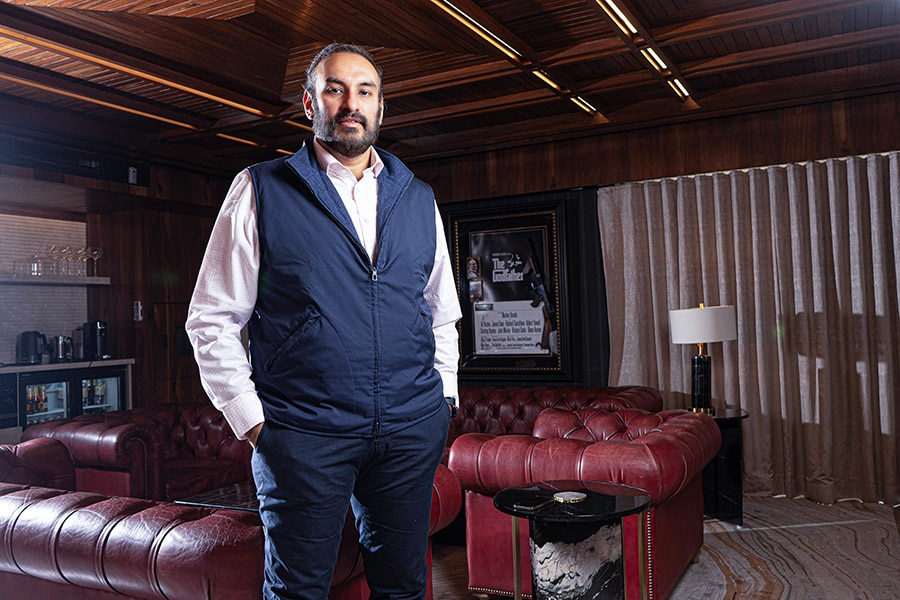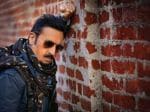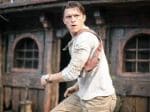With technology, Indian filmmakers will be able to deliver experiences like any other film in the world: Namit Malhotra
The entrepreneur-producer and CEO of British visual effects company DNEG who has made a mark in Hollywood with projects such as Oppenheimer and The Garfield Movie on the importance of VFX and animation, and why he believes Indians have the talent and filmmaking prowess to match the West
 Namit Malhotra, Producer and CEO of British visual effects company DNEG
Image: Neha Mithbawkar for Forbes India
Namit Malhotra, Producer and CEO of British visual effects company DNEG
Image: Neha Mithbawkar for Forbes India
Namit Malhotra was deeply enamoured by filmmaking as a youngster. Born into a film family—his grandfather [MN Malhotra] was a cinematographer while his father [Naresh] produced blockbusters like the Amitabh Bachchan-starrer Shahenshah—in Mumbai, he was initially inclined towards direction until he saw Jurassic Park (1993) and was blown away by the creativity and vision of Hollywood. “Jurassic Park became a big eye-opener for me… it got me excited about what the world of filmmaking or storytelling could be if one leveraged technology,” he says.
The 48-year-old recently tasted success with projects such as Christopher Nolans’s Oscar-winning Oppenheimer, The Garfield Movie and Dune: Part Two. He’s also been closely associated with the Hindi film industry as producer of Brahmastra: Part One – Shiva and the upcoming Ranbir Kapoor-led Ramayana. In an interview with Forbes India, the entrepreneur speaks about the future of storytelling, the role of VFX and animation, and the difference between working in Hollywood and Bollywood. Edited excerpts:
Q. How did you get into visual effects?
I wasn't necessarily in love with computers as a youngster. As a teenager, when I told my father I wanted to make movies, he encouraged me to think about computer graphics… how filmmaking and technology could come together. After giving that a shot, I found it to be a lot more interesting. That’s how I got started. And then I brought over three guys who taught me computer graphics, and we set up a little garage startup.
Q. What were your initial projects?
Even though I say computer graphics… we started as a post-production studio, and started doing TV shows, designing title sequences and music videos. Those were early days of satellite television and some of these became popular TV shows—Boogie Woogie and Colgate Top 10, for instance.
Q. What was the turning point in your career?
There have been a few. We started in 1995 and in two years, we had 15 TV shows running on air every week, which was unprecedented. We had grown from one editing studio to seven. And then, in 1997, when I was 21, we formed Prime Focus and decided to take a deep plunge into the advertising industry.
Q. What was the idea behind Prime Focus?
The prime focus of the company was people. That is how we coined the name Prime Focus, because we said we don't have the money, we don't have the big technology investments, we don't have great facilities, we don't even have that much experience… we are nothing but a group of young and enthusiastic kids who’ve found this sweet spot and want to do cool stuff. That’s how we started. And I was taking a pretty substantial financial risk. We were buying computers or investing in a computer which was twice the revenue of the company in the last couple of years. If something would have failed, that would have been the end of everything for us. That was a massive turning point, and a big risk that we took at the same time was to move from being a television studio to commercials. We had all the forces against us—from experience and quality to investment and locations… we were fighting from all sides, and that became a big game changer for us.
Q. Nearly three decades later, have you achieved what you set out to do with Prime Focus?
There were no grandiose plans of being a garage startup and being the biggest in the world. We would sit and I would set what I would call are achievable targets. I would say, ‘Okay, in the next five years, we’ve got to be at the top of this particular piece’, and then we would just rally together and get there. So it’s been a journey… and 30 years later, to grow from that little, insignificant garage startup to being the biggest integrated services facility in the world is a massive transformation. Coming out of India… it’s been an incredibly proud moment for me personally. But that has happened organically.
Also read: Every failure teaches you the value of success and increases the hunger for it further: Akshay Kumar
Q. You’ve worked on blockbusters like Star Wars, Harry Potter and Dune. What was your experience of crossing over?
This started to happen in the early 2000s when the big IT companies from India had already made a substantial transition from India to the West. And I would think to myself, ‘We're in the film business where we knew how to make movies before we knew how to use computers’… and for whatever reason, Hollywood has never trusted India or Indians to do that in the many decades that we've existed. So I took that upon myself and said, if they can do it in the IT industry, I'll do it in the film business or in the entertainment services side.
And that got my ideas flowing. In 2006-07, we bought studios in the UK, followed by the US. And while it looks great today, the journey became incredibly hard because we walked straight into the financial recession in 2007-08. That hurt the companies that I had bought because they were not necessarily the biggest or the best names. They were decent companies which had a promise of the future, but didn't necessarily have the financial success or creative résumé that one would like… that was something we wanted to build upon. So it was much harder and much more complicated than I had imagined. The culture, the style of working… everything was extremely different to what we were used to. And with an unprecedented financial recession—one that hadn't happened in 100 years—it was quite a task, and I was lacking experience as an entrepreneur as well.
Q. Purely from a working style perspective, is there any difference between Hollywood and Bollywood?
I think there's a fair amount of difference. The Indian film industry is different in the sense that it’s much more entrepreneurial. Filmmakers, producers raise their own money, put up their own cash, they take the risk, they hire people and they do the whole thing. It’s an individual-led mindset, whereas Hollywood has become 90 to 95 percent studio-led—more organised and structured. The biggest studios make the biggest of movies, and everybody works for the studios in some capacity or the other.
Q. Among your recent successes is Oppenheimer. What was your challenge of working on visual effects for that film and how satisfying was winning the Oscar?
Christopher Nolan [director of Oppenheimer] is one of my favourite filmmakers of all time. Before we started working on his films, DNEG was already working with him… on Batman Begins, Inception and The Dark Knight Rises. When I bought the company, we were working on Interstellar. I see him as a very evolved and unbelievable thinker in how he tells his stories. And Oppenheimer became another testament to his talent. We had won for Inception, Interstellar and Tenet for best visual effects… but this was the first Oscar for Christopher Nolan [for Best Picture and Best Director]. So I was incredibly enthused about him winning an Oscar because I believe he deserves all that and much more.
He has a specific style of filmmaking, where he loves to do everything in camera. For Oppenheimer, the team had to come up with running certain types of simulations and visualisation that would have to be created in such a form, in physical and digital form, that had to work within the vision that he had… some of it was rendered digitally to flow in, creating how the bomb comes together, and how the visuals of that would be shown without causing unnecessary destruction. Bringing that to life was something we had to really work hard at, to not blow things up, but create what the energy particles could look like, and how it illuminates, how it all comes together, and that, I think, was interesting and challenging in a film that actually did not need much visual effects to start with.
Q. You work a lot on animation too. What all do you keep in mind when you produce a film like Garfield, for instance?
In animation, you actually make an entire film. Unlike visual effects, where you add to what’s being made, in animation, you’re making the film because every piece of image that you see is created by us. It's all about bringing the characters to life, bringing in the look, and at the same time, the performances become incredibly important. So, it’s much more holistic in terms of what we do. In animation, every component, every piece of the image is brought together by us.
Q. You are working on big projects in India too, like the Ramayana. What is your impression about the content that we are churning out here?
I feel we are 20 years late in finally getting there… but I'm glad that we are getting there. That’s how I had anticipated or planned my own career… I pivoted to the West because India wasn't making those kind of movies. There’s no question that we have all the talent and the filmmaking prowess to do anything and everything the world does. And I'm seeing so much more excitement in filmmakers today to bring certain stories to life. That has never been the case. It's a great step forward for our industry… because we have so much depth in history, in our characters, in mythology, in so many aspects of storytelling that, with the use of technology, Indian filmmakers will be able to deliver experiences like any other film or filmmaker in the world. And that is incredibly exciting to be a part of and to bring some of it to life.
Q. You are on the tech side of things. Do you still have directorial aspirations?
Not really… because I've, over the years, started to appreciate the level of commitment and detail a filmmaker has to apply. And with everything that I do and all the things that I have to manage, I don't see myself being able to disassociate or remove myself from everything. So, while direction was certainly something I was excited by earlier, I think now I could be the best producer in the world… and that's what is driving me forward.


















